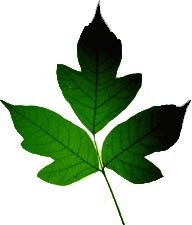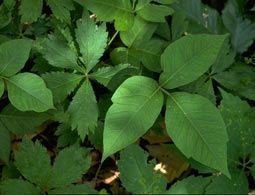Main Content
Article
Poison Ivy

Poison Ivy Leaf
A master of disguise, poison ivy can take the form of a vine, shrub or ground cover. It can have shiny leaves or dull leaves. The leaf edges can be smooth or notched. So how can you spot poison ivy? The phrase "Leaves of three, let it be" is a pretty good rule of thumb. Whether hiking in the woods or playing in a field, beware of any plant with three leaflets.
The cause of all those itching horrors is a chemical called urushiol. Contact through the skin can cause a rash and or blisters. Breathing it in can irritate the lining of the lungs - this usually happens when poison ivy is burned because the smoke can contain the chemical.
A common poison ivy myth is that scratching will cause the rash to spread. This is untrue. Although it may seem that the rash may spread over time instead of all at once, it will only occur where the urushiol has touched the skin. This is either because the urushiol is absorbed at different rates in different parts of the body or because of repeated exposure to contaminated object or having the chemical trapped under the fingernails. Scratching can cause an infection, so fight the urge to scratch!

Poison Ivy
Urushiol is found in the woody vining stems that climb tree trunks. You can recognize poison ivy vines in winter when the leaves have dropped by looking for (but not touching!) tiny rootlets that anchor the poison ivy vine to the tree. Grapevines, which are also woody and have similar growth habits, do not have these tiny rootlets.
Besides providing humans with days of itching and scratching, you may ask yourself "Does poison ivy have any good uses?" Surprisingly, for some wildlife there is. In the winter when food is scarce, some birds will eat the white berries and deer will munch on poison ivy twigs. So remember, while you are itching (but not scratching!), that the poison ivy you tangled with may be helping local wildlife through the winter.
